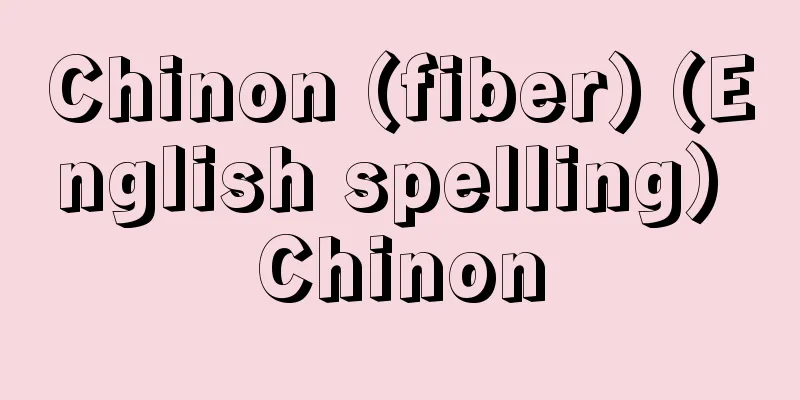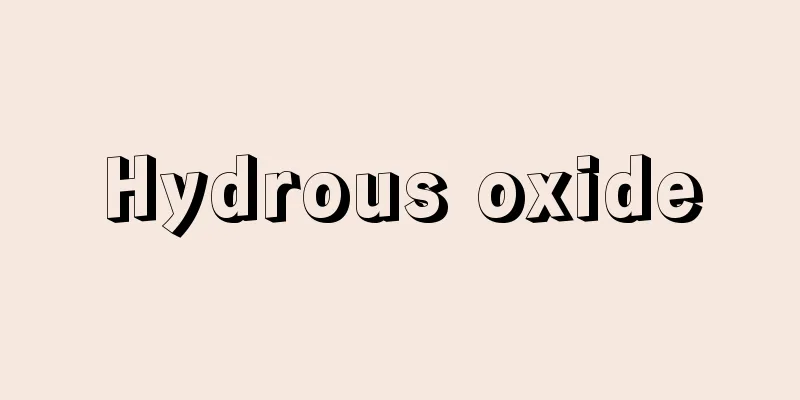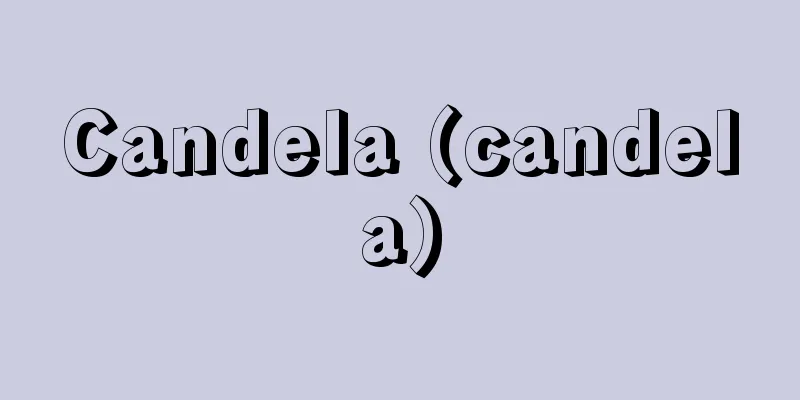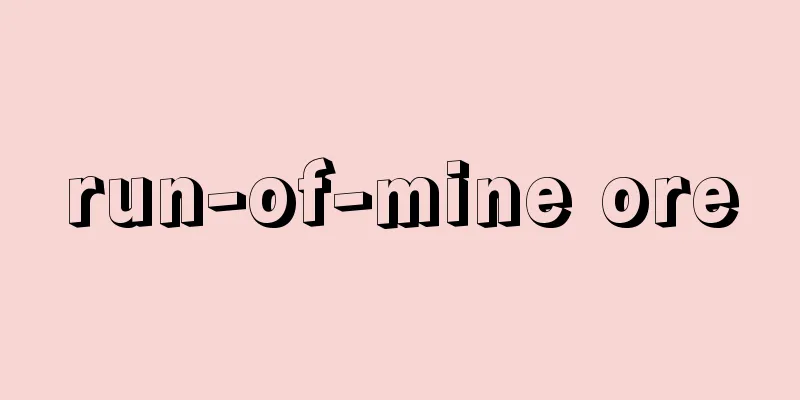Punishment
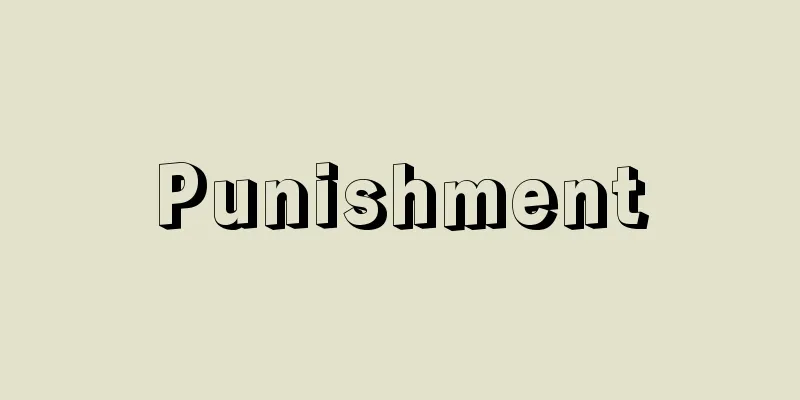
|
It refers to the legal sanctions imposed on those who commit crimes. Currently, in almost all countries, the power to punish is exclusively in the hands of the state, so punishment in those countries means the deprivation of benefits that the state imposes on private individuals as a legal effect for crimes. In Japanese criminal law, the term "penalty" is used, rather than the term "penalty." A penalty is an individual, concrete punishment that exists in law as a specific type, or that is handed down or executed against a specific perpetrator. The change of a penalty, the determination of a penalty, the execution of a penalty, the extinction of a penalty, and so on, are all matters that the criminal law deals with, and these are all punishments in their various forms. In contrast, "penalty" is a name given to an abstract concept. It is not a penalty but a punishment that corresponds to the general concept of a crime, rather than to individual crimes such as theft or murder, and it is also not a penalty but a punishment that stands alongside compensation for damages, which is a legal effect under civil law, and administrative penalties, which are a legal effect under administrative law. In this way, it can be said that "penalty" is a name given to the manifestation form of punishment. [Haruo Nishihara] kindsPenalties are divided into life sentences, corporal punishment, imprisonment, honorary punishment, and property punishment, depending on the type of benefit taken away. Japan's current criminal law does not recognize corporal punishment or honorary punishment, and only recognizes the death penalty as a life sentence, imprisonment, incarceration, and detention as penalties of imprisonment, and fines, minor fines, and confiscation as property penalties. These penalties, imprisonment, incarceration, fines, detention, and minor fines are considered the principal penalties, and confiscation is considered an additional penalty (Article 9). A principal penalty is a penalty that can be imposed independently, and an additional penalty is a penalty that can only be imposed in addition to another penalty. (1) Death Penalty Under current law, the death penalty is prescribed as a punishment for 14 serious crimes, including treason, arson, murder, and robbery-murder. Currently, countries around the world use methods of execution such as hanging, decapitation, shooting, gassing, and electrocution, but Japan has consistently used hanging since the Meiji era, except for the death penalty under the Military Penal Code before the end of World War II. Systemically, the death penalty is to be carried out by order of the Minister of Justice within six months of the date of the finalization of the sentence, except in certain cases. (2) Imprisonment: A type of penal servitude, in which the offender is detained in a penal institution and forced to perform specified work. There are two types: life imprisonment and fixed-term imprisonment, with fixed-term imprisonment lasting from one month to 20 years. (3) Imprisonment: A type of penal servitude that involves detention in a penal institution, but unlike imprisonment, prisoners are not forced to do work. However, prisoners can be made to do work at their request. Under the current Criminal Code, imprisonment is considered a type of punishment for political crimes such as rebellion and rioting, and for some negligent crimes such as professional negligence resulting in death and professional negligence causing fire. Like imprisonment, it is divided into life imprisonment and fixed term imprisonment, and fixed term imprisonment is for a period of one month to 20 years. (4) Fines: A type of property penalty, along with imprisonment, it is widely used as a legal effect for a wide variety of crimes. The amount of the fine is subject to upper and lower limits set for each crime, with the minimum being 10,000 yen. Those who are unable to pay the fine in full are to be detained in a labor camp for a period of one day to two years. (5) Detention: This is a type of imprisonment and, together with a fine, is a type of punishment for very minor crimes. The period is between one and 30 days, and the content is detention in a penal institution. (6) Fines: A type of property penalty, along with detention, is considered to be a type of penalty for very minor crimes. Under the current Criminal Code, the amount is between 1,000 and 10,000 yen. Those who are unable to pay the fine in full will be detained in a labor camp for a period of between 1 and 30 days. (7) Confiscation Because this is an additional penalty, it cannot be imposed independently. It can only be imposed in conjunction with other penalties. The objects that are subject to confiscation are those that constitute a criminal act, such as a forged document in the case of using a forged document, those that are used or intended to be used in a criminal act, such as a weapon in the case of assault, those that result from or are obtained through a criminal act, such as counterfeit currency or stolen goods, or those that are obtained in return for a crime. However, the court may confiscate the above objects only if they do not belong to anyone other than the criminal. However, if a person other than the criminal acquires the object after the crime with knowledge of the circumstances, it may be confiscated even if it belongs to a person other than the criminal. [Haruo Nishihara] HistoryThe history of punishment begins with the history of humanity. Humans have a tendency to live in groups due to their instinct for self-preservation, and norms are always necessary for this group or social life. Where norms exist, there are usually sanctions that involve the deprivation of certain benefits that are imposed in case of violation of the norms. Since the deprivation of benefits as a reaction to violation of norms can be considered a kind of punishment regardless of its form, it can be said that punishment arose when humans began to live in society and has changed along with the changes that occurred. In fact, the evolution of punishment in various countries around the world has followed a similar process to the present day, while reflecting the peculiarities of each ethnic group. [Haruo Nishihara] WesternThe penal system of ancient Germanic peoples is the best example of the primitive form of punishment in the West. Germanic peoples emerged in history with a unit of a blood-relationship community (clan) called Sippe (German), and the penal system was also based on this Sippe. In other words, the ancient Germanic criminal law was divided into three types: internal criminal law, external criminal law, and common criminal law, but all of them were based on the Sippe. The first type of internal criminal law established the disciplinary power of the head of each household within the zippe. If the perpetrator was a free citizen, this was often accompanied by flogging or banishment from the zippe, while if the perpetrator was a slave, he or she was beaten, restrained, or in some cases killed. The second type of external criminal law was the criminal law governing the relationship between zippes. When a member of one zippe committed a crime against a member of another zippe, the victim or anyone who heard his screams had the right and duty to kill the perpetrator in the act. If the crime was discovered overnight, a hostile relationship called Fehde arose between the zippe to which the victim belonged and the zippe to which the assailant belonged, and the members of the former had the right and duty to exact revenge (blood vendetta) against the members of the latter. Here, too, we can see a primitive form of public punishment. However, since the public recognition of such revenge led to a state of war between the zippes and was a serious threat to the peace of the people, in later times the perpetrator could hide in a shelter and wait for an opportunity to negotiate a settlement, or pay a ransom to avoid revenge. The third common criminal law prohibited rebellion against the entire people, and in cases of religious crimes such as the plundering of temples, the looting of corpses, and the commission of sorcery, rebellion against the monarch or state, desertion from the army, and shameless crimes such as nighttime theft, rape, and border infringement, a legal effect called "Loss of Peace" was given to the perpetrator, who was not only banished from Zippe, but also had all legal relations dissolved, and anyone was free to kill him. However, in later times, all members of the People's Assembly came to jointly execute the sentence for this type of criminal, and the types of punishment were also categorized according to the crime, such as hanging for theft, execution by car for secret murder, beheading for rape, and burial alive in a swamp for sexual immorality. During the Frankish Empire, a national system of punishment gradually developed, and it began to include the punishment of the head of a family, the revenge between clans and the payment of ransom money, and the punishment for forfeiture of peace. The types of punishment also diversified, and in addition to life punishments such as hanging, decapitation, drowning, burial, burning, tearing by a cart, tearing by horses, and dragging to death, various corporal punishments appeared. These included amputation of body parts, flogging, shaving, and branding. Most of these were reflection punishments, such as cutting off the hand used to swear a false oath, pulling out the tongue of a blasphemer, castrating an adulterer, and branding a counterfeiter on the forehead. The ransom money was paid to the victim or his clan at first, but it was later split between the state and the victim, and in later times the state received a much larger share of it, turning it into a fine. Thus, revenge gradually decreased, and was only permitted in cases of murder, adultery, and the rape of women. Criminal law in medieval Europe developed mainly as local customary law, but the distinctive feature of the penal system was that it was centered on life and corporal punishment as mentioned above, while property penalties such as fines were no longer in use and instead honor punishments such as public exhibition and parade began to appear. In the early modern period, cruel life and corporal punishments continued to exist. The German Carolina Code, enacted in 1532, was outstanding in Europe in terms of its criminal justice system, but its punishment system was still severe and cruel. Death sentences such as hanging for theft, decapitation for robbery, quartering for treason, impalement for indecent acts, burning at the stake for witches, and execution by cartwheel for parricide and husband-murder were permitted, as well as corporal punishments such as the gouging out of eyes for those who insulted official authority, the cutting out of ears for thieves, the cutting out of tongues for those who insulted God, and the cutting off of fingers for minor offenses. The Carolina Code's penal system was a comprehensive catalogue of cruel punishments in the Middle Ages, and it exerted a tremendous influence on other local laws throughout the absolutist era of the early modern period. The Criminal Museum in Rothenburg, Germany is famous as a complete collection and exhibition center of the tools of punishment and torture used during these periods. However, even during this time, the desire for a modern penal system had already begun to emerge. The penal yard in Amsterdam in the early 17th century is famous as the birthplace of the modern penal system. However, in order for such a modern and rational penal system to oust the gruesome and cruel penal system of the Middle Ages, it was necessary to wait for the Enlightenment ideas of the 18th century and the criminal legislation influenced by them. In particular, the French Criminal Code of 1810, with its progressive penal system, led the criminal legislation of other countries. [Haruo Nishihara] JapanAs in many ancient societies, law and religion were not separate in ancient Japan. Therefore, the concept of crime, or "tsumi," did not necessarily consist of acts that violated norms, but also included facts that could not be attributed to an individual's responsibility, such as illness and natural disasters. In other words, the first type of "tsumi" was acts that violated the order of agriculture, such as leaving ridges, filling in ditches, leaving gutters, sowing too much (sowing more seeds in a field that had already been sown), and stabbing (sticking a stick into someone else's field). The second type was impure acts (sorcerous acts) related to the killing of humans, such as skinning (skinning a living animal), skinning (skinning a living animal starting from the rear end), and defecation. The above were considered to be Amatsutsumi. On the other hand, the third type and below were considered to be Kunitsutsumi. The third type included impure acts such as kihada-dachi (slicing the skin alive) and kihada-dachi (slicing the skin dead). The fourth type included diseases such as Shirohito and Kokumi. The fifth type included sexual violations such as sins against one's mother, sins against one's child, sins between mother and child, and sins against animals. The sixth type included accidental misfortunes such as the misfortunes of insects (such as being bitten by a snake), the misfortunes of Takatsukami (lightning strikes), and the killing of animals. The seventh type included curses such as the misfortune of using evil spirits. Although the above types are quite different in nature, in ancient society they were all considered to be acts abhorred by the gods, and in that respect they shared a commonality as "tsumi." If the concept of "tsumi" was such, then the corresponding effects would naturally have a religious character, and the corresponding "harai" (exorcism) and "misogi" (purification) were both considered to be means to remove the impurity caused by "tsumi." It is generally believed that these "harai" and "misogi" are the original forms of punishment in Japan. In many other ancient societies, the original form of punishment was revenge, but there are no documents to convey this in Japan. However, in the later period of the ancient period, as the production of ironware progressed and Confucianism began to be introduced from China, the primitive religious sentiments of the past were lost, and among "tsumi" (crimes) there was a differentiation between those resulting from human actions and others, and for "tsumi" (crimes resulting from human actions), punishments other than the traditional "harai" and "misogi" (purification) were imposed. Punishments in this era included death, exile, banishment, denigration, confiscating, and other punishments, but it is said that corporal punishment such as breaking the knee muscles was also practiced. Methods of execution included hanging, decapitation, and burning at death's stake, and in the case of serious crimes, enza (enza) was also practiced, which involved the death of the perpetrator's wife and children and the annihilation of his family and clan. Generally, the 364 years from 603 (the 11th year of the reign of Empress Suiko) to 967 (the 4th year of the Kōhō era) are called the Jōsei period, during which cultural artifacts from China were imported into Japan in a remarkable way, and especially after the Taika Reforms (645), a centralized national system modeled on the Tang Dynasty was established, and in the field of law, an era of fully-fledged written law was ushered in, centered on the Taihō Code (701) and the Yōrō Code (718). Punishments in the Ritsuryo period were modeled on the Tang Dynasty codes and consisted of five types (five crimes = five penalties): whipping, caning, execution, exile, and death. However, following the Japanese tradition since ancient times, the character for punishment was not used, and the character for crime was added to each of the terms, as in caning and caning. In Japan at that time, there were no terms equivalent to modern-day punishments, and the relationship between crimes and punishments was unclear; the two were undifferentiated, and the type of punishment simply indicated the type of crime. A whip was a punishment in which a person was beaten on the buttocks with a thin tree branch, while a cane was a thick tree branch. There were five grades of whip, ranging from 10 to 50, and canes, ranging from 60 to 100. Penal servitude was a hard labor punishment lasting from one to three years. Exile was a punishment in which the person was exiled to a remote area and not allowed to return for life, and there were three types depending on the distance from the capital: far exile, middle exile, and local exile. Death was either beheading or hanging. In addition to the five penalties mentioned above, there were additional penalties such as confiscation of official position and exile, and alternative penalties such as appointing a janitor (instead of a prison sentence) and residence in exile (instead of exile), and leap penalties (special punishments for people of high status) were also permitted for persons of high rank and monks. The above-mentioned penal system of the Ritsuryo period was maintained even in the later period of the ancient period, but its application changed. Many formal decrees were issued to amend the Ritsuryo code, and the precedents of the Kebiishi Office were respected as so-called office examples, and in some cases even contradictory laws were recognized. In addition, due to the influence of Buddhism at that time, there was a tendency to lighten the sentences, and especially after 811 (Kōnin 2), there was a custom of the Imperial Court reducing the sentence by one level by a special decree and sentencing the person to exile, and it is noteworthy that no executions were carried out for a total of 345 years until 1156 (Hōgen 1). The public land and citizen system of the Ritsuryo period had already begun to decline toward the end of the ancient period, and in its place the manor system developed. The manorial feudal society gave birth to the samurai class, which gained power, and with the establishment of the Kamakura Shogunate, samurai law appeared throughout the country. Of the ritsuryo period's whipping, caning, punishment, exile, and death, the Kamakura Shogunate only inherited beheading as a capital punishment and exile as a distant exile, and abolished all other punishments. In addition to that, it adopted property punishments such as confiscation of land, honor punishments for samurai such as permanent non-service, termination of service, and disownment, and physical punishments for commoners such as finger-cutting, branding with fire (pressing a mark on the forehead), and shaving one side of the temple, making the punishment system significantly crueler than in the previous era. This was a manifestation of the militaristic ideology of the time, and the Muromachi period that followed followed in a similar fashion. During the Sengoku period, the penal system developed slightly differently in each region, but generally it was harsh and cruel, reflecting the trends of the time. Cruel methods of execution included crucifixion, upside-down crucifixion, skewering, sawing, splitting the body into pieces, splitting the body into pieces on a wheel, roasting, boiling in a pot, and wrapping. Inhumane corporal punishments such as cutting off fingers and hands, cutting off noses and ears were also frequently used. This can be called a dark age in the history of Japanese penal punishment. Even after the Edo Shogunate was established, this harsh penal system was maintained for some time, but from the middle of the Edo period onwards, it was gradually relaxed, and especially after the eighth Shogun, Yoshimune, made major reforms to the penal system, the excessively diverse types of punishment were significantly streamlined. The life sentences allowed were sawing, crucifixion, execution by beheading, execution by ... Among these types of punishment, banishment was used most frequently at the time, but banished people often became homeless and committed crimes one after another, which caused problems in terms of maintaining public order, so in 1790 (Kansei 2), a labor camp was established in Tsukudajima, Edo (Chuo Ward, Tokyo) to gather homeless people, give them a job, and rehabilitate them. This is famous as the beginning of modern imprisonment in Japan. The first Provisional Penal Code, which was enacted after the Meiji Restoration, imitated the Ritsuryo system and allowed four types of punishment: flogging, execution, exile, and death. The new Ritsuryo Code, which was enacted afterwards, was also based on the Ritsuryo system and restored all five of the punishments: flogging, execution, exile, and death. However, the Revised Ritsuryo Code, which was somewhat influenced by Western law, abolished the flogging and execution in principle and replaced them with imprisonment. The old Criminal Code, which was modeled after the French Criminal Code, allowed a wide variety of types of penalties, so the number of punishments increased to many, including the death penalty, life imprisonment or fixed-term imprisonment, life or fixed-term exile, heavy or light imprisonment, heavy or light imprisonment (all of which are the main punishments for serious crimes), heavy or light imprisonment, fines (all of which are the main punishments for light crimes), detention, fines (all of which are the main punishments for police violations), and additional punishments such as deprivation of public rights, suspension of public rights, surveillance, fines, and confiscation. The current Criminal Code has greatly restricted the types of imprisonment and abolished honorary punishments such as the deprivation of public rights and the suspension of public rights, limiting it to only the seven types mentioned above. [Haruo Nishihara] EssenceThere is a debate about the nature of punishment. The view that punishment is a harm imposed as a reaction to the harm of crime is called retributive punishment theory, while the view that punishment is a purposeful means to prevent future crimes and thereby protect society is called teleological punishment theory. The theory of retributive punishment originates from the Enlightenment view of humanity, which holds that all human beings are born equally endowed with reason and are able to act according to that reason, and that punishment is imposed solely for the reason that such a rational person has committed a crime, and does not pursue any other purpose. However, as the natural sciences gradually developed in the 19th century, the Enlightenment view of humanity, which is the basis of the theory of retributive punishment, came under criticism, and instead, the natural science view of humanity, which holds that human behavior is restricted by inclination and environment, came to prominence. The theory of tertiary punishment was strongly advocated at that time, based on such a view of humanity. Among such theory of tertiary punishment, the position that understands punishment as a means to educate criminals and reintegrate them into society is called educational punishment. However, in the 20th century, as the view of humanity that respects human reason and emphasizes decisions made by free will regained its position, the theory of retributive punishment changed its form and was emphasized, and it can be said that it is now the dominant view. Modern retributive punishment theory regards the essence of punishment as retribution, but interprets this retribution as a normative retribution that takes into account the individual circumstances of the perpetrator, such as disposition and environment, rather than retribution for an objectively committed illegal act. At the same time, it has developed a so-called relative retributive theory that approves that punishment serves the function of preventing crime or preserving society as an effect of retribution or within its limits. [Haruo Nishihara] functionAs mentioned above, even if punishment is normatively retributive in its essence and harmful in its content, this does not deny that punishment as such performs a function that transcends its essence in the reality of social life and serves a good function for human beings. Punishment can be broadly classified into four functions: warning, retributive, security, and preventive. (1) Function of forewarning First, when penalties are included in a legal code, they serve the function of forewarning the public and those involved in the judicial system as to what acts will be punished and what penalties will be imposed for what crimes. (2) Retributive Function When a punishment is handed down by a court or, even further, when it is actually carried out, punishment begins to perform a retributive function. That is, it serves the function of assuaging and satisfying the feelings of retribution of the victim or his/her surviving family, and of society in general. As long as the state has a monopoly on the right to punish and prohibits private revenge, and as long as the desire for revenge does not disappear from human beings, punishment cannot help but perform this function. And from the standpoint of the prisoner, this retributive function can be seen as an expiatory function in which the inmate atones for his/her crime by undergoing punishment. (3) Security function When we consider the punishment being carried out in relation to society in general, we can see that it serves the function of preserving society. However, this function of punishment is hardly present in property penalties, and there are also cases where life penalties and imprisonment penalties must be imposed even when there is no need for security, so this function of punishment cannot necessarily be said to be common to punishment in general. (4) Preventive Function The preventive function of punishment is further divided into general preventive function and special preventive function. The general preventive function is a function that prevents crimes by intimidating ordinary people, and therefore it is a function that can be performed at any time, whether the sentence is written in the law, handed down by the court, or actually executed. In contrast, the special preventive function is a function that acts on the criminal himself and prevents him from committing new crimes, and therefore it is activated at least when the sentence is handed down, and it is fully active at the stage of execution of the punishment. That is, all kinds of punishments perform the function of impressing upon rational people the anti-normative and anti-social ethical meaning of their actions, and warning them not to commit crimes again in the future. In particular, since imprisonment is executed continuously for a certain period of time, there is a great deal of room for it to directly affect the prisoner's inner self and serve as a special crime prevention measure using psychological and sociological methods. [Haruo Nishihara] ApplyThe application of a penalty means handing down a punishment to a specific perpetrator. The application of a penalty is currently left entirely to the courts, and there are no exceptions to this. The most important issue in the application of a penalty is the determination of the type and amount of the penalty. Penalties are usually stipulated in each individual article with a certain degree of freedom. In this way, the penalty set out in each article for each individual crime is called the "statutory penalty." For example, the statutory penalty for murder is "death penalty or life imprisonment or imprisonment for five years or more" (Article 199 of the Penal Code). The first and foremost standard in the application of a penalty is this statutory penalty. Next, in the application of a penalty, it is necessary to aggravate or reduce the statutory penalty. The circumstances in which a penalty should be aggravated or reduced are stipulated in the General Provisions of the Penal Code. This is called a legal reason for aggravation or reduction. Even if there is no legal reason for reduction, it is possible to reduce the penalty for each individual crime by taking into account the circumstances of the crime. This is called a mitigation for leniency. There are certain rules regarding how to aggravate and reduce the sentence (Articles 66-72 of the same Act), but the punishment obtained by aggravate and reduce the statutory punishment in this way is called the "punishment penalty." It is usually the case that punishment penalty exists, in line with the statutory punishment, which is appropriate for each individual crime within the scope of such punishment penalty, and sentence it. The punishment that should be given in this way is called the "punishment penalty." In determining a sentence, it is considered to be intended to be useful in controlling the crime and correcting the perpetrator, taking into consideration not only the size of the illegal act, but also the age, personality, background, environment of the perpetrator, the motive, method, consequence, and social impact of the crime, as well as the attitude of the perpetrator after the crime, and to help control the crime and correct the perpetrator's improvement and correction. [Haruo Nishihara] ExecutionExecution of a sentence refers to the realization of the sentence given to a particular actor in a sentence. This is the principle that it is carried out immediately after the trial is finalized. However, the execution of the death penalty requires that the Minister of Justice be further ordered. Furthermore, when the execution of imprisonment, imprisonment, and fines is given in conjunction with this, if a suspended sentence is given, it cannot be executed until the trial for revocation is finalized. As a general rule, execution of a sentence is conducted by an executive officer or an executive officer under the direction of the prosecutor's office, which corresponds to the court that held the trial, in accordance with the type of punishment. [Haruo Nishihara] DisappearanceThe extinction of a sentence refers to the extinction of the right to execute the sentence after a legal prosecution is filed and a final sentence of guilty is found. There are four reasons for the extinction of a sentence: the death of the perpetrator or the extinction of the corporation that is the perpetrator, pardon, statute of limitations, the period of probation for the sentence, and the expiration of the parole period. [Haruo Nishihara] Statute of Limitationsになったんです。 English: The first thing you can do is to find the best one to do. However, as society began to feel more sympathy for the retribution sentiment of victims and survivors from around the end of the 20th century, the abolition of statutes of limitations became prevalent, especially for the statute of limitations for the statute of limitations that were shortened (for example, for crimes subject to death penalty, 5 years for crimes subject to imprisonment for less than 10 years), and the Code of Criminal Procedure in 2010 was amended. As a result, the statute of limitations for crimes that resulted in death was 30 years, but for crimes that resulted in life imprisonment or imprisonment, the statute of limitations for the crimes that resulted in death were 20 years, for those that were long-term imprisonment or imprisonment, and for those that were not subject to the statute of limitations for death were excluded from the statute of limitations for the statute of limitations for the death penalty. At the same time, the Criminal Code was amended, and the statute of limitations for the death penalty was abolished (Article 31 of the Criminal Code), and the duration of the statute of limitations for other sentences was 30 years for life imprisonment or imprisonment, 20 years for fixed term imprisonment or imprisonment for more than 10 years, 10 years for more than 3 years, 5 years for less than 3 years, and 3 years for fines, and one year for detention, fines, and confiscation (Article 32 of the Act). [Haruo Nishihara] Penalty in a non-letter societyIn a society without letters, punishments in civilized society are imposed on perpetrators by publicly organized institutions. The types of punishments in society without letters are of course different from those in civilized society, including death penalties, expulsion, slap, corporal punishment such as the confiscation of property, restoration of originality, and atonement, but punishments such as prison do not generally exist. These punishments vary in various ways, such as corporal punishment, for example, in the case of corporal punishment, New Zealand's Māori courts order those who commit theft, insulting a traveler, or certain delinquents to beat their heads and chest with stones until they are bleeding, but sometimes the perpetrator bites a poisonous grass that makes the mouth swell, causing severe pain. In addition, torture for a theft can be tied up the perpetrator's hands and feet and left on a burning day. になったんです。 English: The first thing you can do is to find the best one to do. になったんです。 English: The first thing you can do is to find the best one to do. These vary from society to society, but as a result of taboo violations, it is to believe in the anger of the supernatural, fear of magical retaliation, etc. Believing that these sanctions are imposed, individuals' modes of conduct are controlled and social order is maintained, and the idea of sanctions in this sense is broader than the concept of punishment in civilized society. [Ariga Toru] "Theory and reality of punishment" (1972, Iwanami Shoten)" (ed.) " by Sasanami Yo Sajiro, "History of Japanese Criminal Legislation" (1967, Yuhikaku) " by Ishii Ryosuke (1992, Akashi Shoten)" by Ishii Ryosuke (1964, Chuokoron Shinsho) " by Ishii Ryosuke (1964, Chuokoron Shinsho) " by Abe Kinya, "Social History of Punishment Officers" by Abe Shinsho (1978, Chuokoron Shinsho)" by Emori Goo, "Law and Morality" (contains "Contemporary Cultural Anthropology 4: Human Society II" by Manshiro, 1960, Nakayama Shoten)" [Reference Items] | | | | | Law | | | | | Statute | | | |Source: Shogakukan Encyclopedia Nipponica About Encyclopedia Nipponica Information | Legend |
|
犯罪を犯した者に科せられる法律上の制裁をいう。現在では、ほとんどすべての国が刑罰権を独占的に国家の手に収めているので、そこでは、刑罰は、国家が犯罪に対する法効果として私人に科すところの利益の剥奪(はくだつ)を意味することになる。 日本の刑法では、刑罰ということばを用いず、刑という名称を用いている。刑というのは、法律のなかに種類を特定して存在し、あるいは特定の行為者に対して言い渡され、あるいは執行されるところの個々具体的な刑罰である。刑の変更、刑の量定、刑の執行、刑の消滅など、刑法が取り扱うのは、すべてそのような形をとった刑にほかならない。これに対して刑罰というのは、抽象的な観念に付せられた名称である。窃盗・殺人といった個々の犯罪ではなく、犯罪という一般的な観念に対応するのは刑ではなく刑罰であり、また民事法上の法効果である損害賠償や、行政法上の法効果である行政罰と並ぶのも、刑ではなく刑罰である。このように、刑というのは、刑罰の発現形態に対して付された名称であるといってよい。 [西原春夫] 種類刑罰は、それによって奪われる利益の種類によって、生命刑・身体刑・自由刑・名誉刑・財産刑に分かれる。日本の現行刑法は、身体刑・名誉刑を認めず、生命刑としての死刑、自由刑としての懲役・禁錮(きんこ)・拘留、財産刑としての罰金・科料・没収を認めるにすぎない。そして、この死刑・懲役・禁錮・罰金・拘留・科料を主刑とし、没収を付加刑とする(9条)。主刑というのは、独立して言い渡すことのできる刑罰であり、付加刑というのは、他の刑罰に付加してだけ言い渡すことのできる刑罰である。 (1)死刑 現行法上、死刑は内乱罪・放火罪・殺人罪・強盗殺人罪など14種の重大な犯罪に対する刑として規定されている。死刑の執行方法としては、現在世界各国で、絞首・断首・銃殺・ガス殺・電気殺などの方法が用いられているが、日本は第二次世界大戦終了前の軍刑法による死刑を除き、明治以来一貫して絞首刑の方法を用いてきた。死刑の執行は、制度上は特定の場合を除き判決確定の日から6か月以内になされる法務大臣の命令によって行われることになっている。 (2)懲役 自由刑の一種であって、刑事施設に拘置し所定の作業を行わせることを内容とする。無期と有期とに分かれ、有期懲役は1月以上20年以下である。 (3)禁錮 自由刑の一種であり、刑事施設に拘置することをその内容とするが、懲役と異なり、強制的に作業を行わせることはない。もっとも、受刑者の請願によって作業に従事させることはできる。現行刑法上、禁錮は内乱罪・騒乱罪などの政治犯と、業務上過失致死罪・業務上失火罪などの過失犯の一部に対する刑種として考えられている。懲役と同じく無期と有期とに分かれ、有期禁錮は1月以上20年以下である。 (4)罰金 財産刑の一種であって、懲役とともに非常に多くの犯罪に対する法効果として多用されている。罰金の額は、それぞれの犯罪ごとに上限あるいは下限を定められているが、その最下限は1万円とされている。罰金を完納することができない者は、1日以上2年以下の期間、労役場に留置することとなっている。 (5)拘留 自由刑の一種であり、科料とともに非常に軽い犯罪に対する刑種とされている。その期間は1日以上30日未満であり、その内容は刑事施設に拘置することである。 (6)科料 財産刑の一種で、拘留と並び、非常に軽い犯罪に対する刑種とされている。現行刑法上、その額は1000円以上1万円未満である。科料を完納することができない者は、1日以上30日以下の期間、労役場に留置することになっている。 (7)没収 付加刑であるから、独立して言い渡すことはできない。他の刑罰とあわせてだけ言い渡すことができる。没収の対象となるのは、偽造文書行使罪における偽造文書のように犯罪行為を組成した物、傷害罪における凶器のように犯罪行為に供しまたは供しようとした物、偽造通貨とか盗品、犯行の報酬のように犯罪行為から生じもしくはこれにより得た物、またはその対価として得た物である。もっとも、裁判所が以上の物を没収しうるのは、それが犯人以外の者に属さないときに限る。ただ、犯人以外の者が犯罪ののちに事情を知ってその物を取得したときは、犯人以外の者に属する場合でも、これを没収することができるものとされている。 [西原春夫] 沿革刑罰の歴史は人間の歴史とともに始まる。元来、人間はその自己保存の本能から集団で生活する習性をもっており、しかもこの集団の生活、社会生活には規範というものがかならず必要になり、そして規範のあるところには、通常、それに違反した場合に科せられる、一定の利益剥奪を内容とする制裁が存在することになるからである。規範違反に対する反作用としての利益剥奪は、それがどのような形式であろうとも一種の刑罰としてとらえることができるのだから、刑罰は人間が社会生活を始めるとともに発生し、その変遷に従って変容を遂げていくものであるといってよい。現に、世界各国における刑罰の進化は、各民族の特殊性を反映しながらも、ほぼ共通した過程をたどって今日に至っている。 [西原春夫] 西洋西洋における刑罰の原始的形態をもっともよく物語るのは、ゲルマン古代における刑罰制度である。ゲルマン民族は、ジッペSippe(ドイツ語)と称する血縁共同体(氏族)を単位として歴史のなかに登場してくるが、刑罰制度もまた、このジッペを単位とするものであった。すなわち、ゲルマン古代の刑法は、対内的刑法、対外的刑法、共通的刑法の三つの種類に分かれていたが、いずれもジッペを単位とするものであった。 第一の対内的刑法は、ジッペ内部における各家の家長の懲戒権を基礎づけるものであり、相手が自由民の場合には鞭(むち)打ち、ジッペ外への追放などがよく行われ、相手が奴隷の場合には打撲・束縛、場合によっては殺害が行われた。 第二の対外的刑法は、ジッペ対ジッペの関係を規律する刑法であって、あるジッペの構成員が他のジッペの構成員に対し犯罪を行った場合には、被害者またはその叫び声を聞いた者は、現行犯人を殺害する権利・義務をもち、犯行が一夜を越えて発見されたときは、被害者の属するジッペと加害者の属するジッペとの間にフェーデFehdeと称する敵対関係が生じ、前者の構成員は後者の構成員に対して復讐(ふくしゅう)(血讐)をなす権利・義務をもったのであった。ここにもまた、公刑罰の原始的形態を認めることができよう。もっとも、このような復讐の公認は、ジッペ間の戦闘状態を招来し、人民の平和を害することが甚だしかったので、後の時代には、犯人が避難所に隠れて和解交渉の機会を待ち、また贖罪(しょくざい)金を支払って復讐を免れることができるようになった。 第三の共通的刑法は、人民全体に対する反逆を禁止したもので、寺院の略奪、死体の略奪、加害呪術(じゅじゅつ)などの宗教上の犯罪や君主・国家に対する反逆、軍隊からの逃亡、それに夜間の重窃盗、強姦(ごうかん)、境界侵犯などの破廉恥罪などが行われた場合には、平和喪失Friedlosigkeitと称する法効果が与えられ、犯人はジッペから放逐されることはもとより、すべての法的関係を解消させられ、誰(だれ)がこれを殺害してもよいとされた。もっとも、後の時代には、この種の犯罪者に対しては民会の構成員全員が共同して刑を執行するようになり、また刑の種類も犯罪ごとに類型化して、窃盗は絞首、秘密殺人は車刑、強姦は斬首(ざんしゅ)、風俗犯は沼地への生埋めなどと定められるようになった。 フランク帝国時代に至ると、しだいに国家的な刑罰体系が発達し、家長の懲戒も、氏族間の復讐やそれにかわる贖罪金支払いも、また平和喪失刑も、そのなかに包括され始めた。それに伴って刑罰の種類も多様化し、絞首・斬首・溺殺(できさつ)刑、埋没刑、火刑、車裂き刑、馬による引裂き・引きずり殺し刑などの生命刑のほかに、種々の身体刑が現れるようになった。身体の部分の切断、笞刑(ちけい)、剃髪(ていはつ)、焼印などの刑罰がこれである。そして、その多くは反映刑であって、偽誓者に対しては宣誓に用いた手を切断し、神を冒涜(ぼうとく)した者はその舌を引き抜き、姦通した男は去勢し、通貨偽造者の額には烙印(らくいん)を押すというようなことが行われた。贖罪金も、最初は被害者やその属する氏族に支払われていたが、やがて国家と折半ということになり、後期には国家に帰属する部分がずっと多くなって、罰金刑化した。このようにして復讐はしだいに減り、わずかに殺人・姦通・婦女略奪の場合にだけ許されるようになった。 ヨーロッパ中世の刑法は、主として各地方慣習法として発達したが、刑罰制度の特色は、前述のような生命刑・身体刑がその中心となり、罰金などの財産刑は影を潜め、そのかわりに晒(さらし)・引回しなどの名誉刑が登場するようになった。 近世初頭においても、残虐な生命刑・身体刑は依然として存続した。1532年に制定されたドイツのカロリナ法典は、刑事裁判制度という点で当時のヨーロッパでは卓越したものをもっていたが、その刑罰制度は依然、峻烈(しゅんれつ)・残酷なものであった。窃盗に対する絞首、強盗に対する断首、国事犯に対する四つ裂き、乱倫行為に対する串(くし)刺し、魔女に対する火刑、親殺し・夫殺しに対する車びきなどの死刑や、官の権威を侮辱した者に対する目をくりぬく刑、窃盗に対する耳をそぎ落とす刑、神を侮辱した者に対する舌を切る刑、軽罪に対する指を切り落とす刑などの身体刑が認められていた。カロリナ法典の刑罰組織は、中世における残虐な刑罰の総目録であり、しかも、それは近世初頭の絶対主義時代を通じて、他の地方法に絶大な影響を及ぼしたのであった。これらの時代に使われた刑罰道具、拷問道具の完備した収集・展示場としては、ドイツのローテンブルク市にある刑事博物館が名高い。 しかし、その間にもすでに近代的な刑罰制度への欲求は萌(も)え出ていた。17世紀初頭におけるアムステルダムの懲治場は、近代的な自由刑制度誕生の地として名高い。しかし、このような近代的・合理的刑罰制度が陰惨・残酷な中世以来の刑罰制度を駆逐するためには、18世紀における啓蒙(けいもう)思想や、その影響を受けた刑事立法をまたなければならなかった。とくに1810年のフランス刑法は、進歩的な刑罰制度を携えて、諸国の刑事立法を指導したのであった。 [西原春夫] 日本多くの古代社会がそうであるように、日本の上代でも、法と宗教とが未分離の状態にあった。したがって、犯罪すなわち「つみ」の概念は、かならずしも規範に違反する行為だけから成り立っているのではなく、疾病や天災など、個人の責任に帰すことのできない事実をも含むものであった。すなわち、「つみ」を構成する第一の類型は、畔放(あはなち)・溝埋(みぞうめ)・樋放(ひはなち)・頻蒔(しきまき)(播種(はしゅ)した田畑にさらに播種して妨害する)・串刺し(他人の田に棒を刺す)などの農耕に関する秩序違反の行為であり、第二類型は、生剥(いきはぎ)(生獣の皮を剥ぐ)・逆剥(さかはぎ)(生獣の皮を尻(しり)のほうから剥ぐ)・屎戸(くそべ)などの人命殺傷に関係する不浄な行為(呪術行為)である。そして、以上は天津罪(あまつつみ)とされた。これに対して、第三類型以下は国津罪(くにつつみ)とされており、第三類型には生膚断(いきはだだち)、死膚断などの不浄な行為、第四類型には白人(しろひと)、胡久美(こくみ)などの疾病、第五類型には己(おの)が母犯せる罪、己が子犯せる罪、母と子と犯せる罪、畜(けもの)犯せる罪などの性的な秩序違反行為、第六類型には昆蟲(はうむし)の災い(蛇にかまれるなど)、高津神(たかつかみ)の災い(落雷)、畜仆(けものたお)しなどの偶然の災厄、第七類型には蠱物(まじもの)せる罪などの呪咀(じゅそ)的行為が属していた。以上の各類型はそれぞれかなり性格を異にするけれども、上代社会においては、それらはいずれも神の忌み嫌うことと考えられたようであり、その点で「つみ」としての共通性をもつものとされたようである。「つみ」の観念がそのようなものであれば、これに対応する効果も当然宗教的な性格をもつことになるのであって、それにあたる「はらい」(祓)、「みそぎ」(禊)などは、いずれも「つみ」によって生じた不浄を除去するための手段と考えられたのであった。この「はらい」「みそぎ」を日本における刑罰の原始形態と考えるのが通説である。他の多くの古代社会では、刑罰の原始形態をなしたのは復讐(ふくしゅう)であったが、日本ではそのことを伝える資料が存在しない。 しかし、上代も後期に至って鉄器の生産が進み、また中国から儒教が伝来し始めると、それにつれて従来のような原始的な宗教感情が失われ、「つみ」のなかで、人の行為に由来するものと、その他のものとが分化するようになり、人の行為に由来する「つみ」に対して、従来の「はらい」「みそぎ」以外の刑罰が科せられるようになった。この時代の刑罰には、死(し)・流(る)・追放・貶姓(へんせい)・黥(げい)・没収などがあるが、そのほか膝(ひざ)の筋を断つ身体刑なども行われたと伝えられる。死刑の執行方法は、絞首・斬首・焚刑(ふんけい)であり、重大な犯罪の場合には、妻子を没し、門戸および宗族を滅するなどの縁坐(えんざ)も行われたようである。 一般に、603年(推古天皇11)から967年(康保4)までの364年間を上世とよぶが、この時代には中国からの文物の到来が著しく、とくに大化改新(645)以降唐に倣った中央集権的国家体制が確立し、法律の分野では、大宝律令(たいほうりつりょう)(701)・養老律令(ようろうりつりょう)(718)を中心とする完備した成文法の時代を迎えることとなった。律令時代の刑罰は、唐律に倣って笞(ち)・杖(じょう)・徒(ず)・流(る)・死(し)の5種(五罪=五刑)であるが、上代以来の日本の伝統に従い刑の字は用いず、笞罪・杖罪というように、それぞれ罪の字を付していたことに注意を要する。当時の日本には、現在の刑罰に相応する用語は存在せず、犯罪と刑罰との対応関係も明らかでなく、両者は未分化で、刑種は罪種を示すものにほかならなかった。笞は細い木の枝、杖は太い木の枝で臀部(でんぶ)を殴打する刑であり、笞には10から50、杖には60から100に至る5等があった。徒は労役刑であって、期間は1年から3年。流(流刑)は辺地に流して終身帰らせないものであり、京からの距離によって、遠流(おんる)・中流・近流の3種があった。死は斬首と絞首に分かれていた。なお、以上の五刑のほかに、付加刑として没官と移郷(いごう)、換刑として加杖(徒のかわり)と留住(りゅうじゅう)役(流のかわりに徒刑を科す)とがあり、また有位者および僧侶(そうりょ)に対する閏(じゅん)刑(身分者に対する特別な刑)が認められていた。 以上のような律令時代の刑罰制度は、上代の後期に至っても維持されたが、その運用には変化をきたした。律令を修正する格式(きゃくしき)が多数発布され、また検非違使(けびいし)庁の先例がいわゆる庁例として重んじられ、場合によっては律令に相反することすら認められるようになったのがこれである。また当時は仏教の影響などから刑を軽くする傾向が生まれ、とくに811年(弘仁2)以降、死刑の判決があっても朝廷が別勅をもって一等を減じ、遠流に処するという慣例が生じ、1156年(保元1)までの実に345年の間、死刑の執行が行われなかったことは注目に値する。 律令時代の公地公民制は上代末期にすでに衰退を始め、これにかわって荘園(しょうえん)の制度が発達してきた。荘園的封建社会はそのなかから武士階級を生み出し、それが勢力を得て、鎌倉幕府の成立とともに武家法が全国に現れることとなった。鎌倉幕府は律令時代の笞・杖・徒・流・死のうち、死刑のなかの斬首と流刑のなかの遠流だけを承継し、それ以外の刑はすべて廃絶してしまった。そして、それに加えるに、所領の没収などの財産刑、永不召仕(ながくめしつかわず)・止出仕(しゅっしをとどむ)・勘当などの武士に対する名誉刑、指切・火印捺(かいんなつ)(額に印を押す)・片鬢剃(かたびんそり)などの庶民に対する身体刑などを採用したため、刑罰制度は前時代に比べると著しく残酷なものとなった。これは、当時の武断的なイデオロギーの発現であり、したがって、その後の室町時代もほぼ同様な形で経過したのである。戦国時代には、刑罰制度は各地方でやや異なった発達をみたが、一般に当時の風潮を反映して過酷・残虐なものであった。磔(はりつけ)・逆さ磔・串刺(くしざし)・鋸挽(のこぎりびき)・牛裂(うしざき)・車裂(くるまざき)・火焙(ひあぶり)・釜煎(かまいり)・簀巻(すまき)など、死刑の残酷な執行方法が行われ、また指切・手切・鼻そぎ・耳そぎのような非人道的な身体刑も多用された。日本刑罰史上の暗黒時代ということができる。 江戸幕府成立後も、当分の間はこのような過酷な刑罰制度が維持されたが、中期以降はしだいに緩和され、とくに8代将軍吉宗(よしむね)によって刑罰制度に大改革が加えられてからは、あまりにも多様だった刑種がかなり整理されることとなった。生命刑としては鋸挽・磔・獄門・火罪・斬罪(武士)・死罪(死屍(しし)は様斬(ためしぎり)にされ、家屋敷・家財は没収)・下手人(げしゅにん)(利欲にかかわらない殺人にだけ科す斬首刑)などの執行方法が認められ、身体刑としては入墨(いれずみ)・敲(たたき)などがあり、自由刑としては入牢(じゅろう)・遠流・追放・閉門・逼塞(ひっそく)・遠慮(えんりょ)・戸〆(とじめ)・手錠(てじょう)・押込(おしこめ)・預(あずけ)などの種類があり、財産刑としては闕所(けっしょ)・過料などがあった。また、名誉刑としては役儀取上・叱(しかり)・隠居などが認められていた。ところで、当時、これらの刑種のうち追放が非常に多用されたが、追放された者が無宿となって犯罪を重ねることが多く、治安維持の観点から不都合をきたしたので、1790年(寛政2)には江戸佃島(つくだじま)(東京都中央区)に人足寄場(よせば)が設けられ、無宿者を集めて、これに生業を与え、更生させる試みがなされた。日本における近代的自由刑の萌芽(ほうが)として著名である。 明治維新後最初に制定された仮刑律は、律令制を模して笞・徒・流・死の4種の刑罰を認め、ついで制定された新律綱領も、律令の基礎のうえにたっていたから、笞・杖・徒・流・死の五刑をすべて復活したが、やや西欧法の影響を受けた改定律例(りつれい)は笞・杖を原則として廃止し、これにかえて懲役をもってすることとなった。フランス刑法を模した旧刑法は、非常に多様な自由刑の種類を認めたため、刑名は多数に上り、死刑、無期・有期徒刑、無期・有期流刑、重・軽懲役、重・軽禁獄(以上、重罪の主刑)、重・軽禁錮、罰金(以上軽罪の主刑)、拘留、科料(以上違警罪の主刑)、および剥奪(はくだつ)公権、停止公権、監視、罰金、没収という付加刑がこれに数えられることとなった。現行刑法は、自由刑の種類をはるかに制限し、また剥奪公権・停止公権という名誉刑を廃止し、前述のような7種のものだけに限定したのであった。 [西原春夫] 本質刑罰の本質については争いがある。刑罰は犯罪という害悪に対し反作用として科せられる害悪だとする見解を応報刑論といい、これに反して、刑罰は将来における犯罪を防止し、もって社会を防衛するところの合目的的な手段だと解する見解を目的刑論という。 応報刑論は、人間は生まれながらにして平等に理性を授けられ、その理性に従って行動することのできるものだとする啓蒙主義的人間観に由来し、刑罰は単にそのような理性人が犯罪を犯したという理由だけによって科せられ、他のいかなる目的をも追及するものでないとする、いわゆる絶対的応報刑論から出発したのであった。しかし、19世紀に入って、しだいに自然科学が発達するにつれ、応報刑論の基礎にある啓蒙主義的人間観が批判されるようになり、むしろ、人間の行動は素質と環境によって制約されているとする自然科学的な人間観が台頭するに至った。 目的刑論は、まさにそのような人間観に立脚して、当時強く唱えられたのである。このような目的刑論のうち、刑罰は犯人を教育し、社会に復帰させる手段だと解する立場を教育刑論という。しかし、20世紀に入って、ふたたび人間の理性を尊重し、その自由意思による決断を重視する人間観がその地位を回復するにつれ、応報刑論が姿を変えて強調され、現在ではこれが支配的な見解ということができるようになった。現代における応報刑論は、刑罰の本質を応報としてとらえながら、その応報を客観的に行われた違法行為への応報ではなく、素質・環境などの行為者の個人的事情を考慮に入れた、いわば規範的な応報と解すると同時に、他方、応報の効果として、あるいはその限度内において刑罰が犯罪の予防あるいは社会保全の機能を営むことを是認する、いわば相対的応報刑論を展開するに至っている。 [西原春夫] 機能前述のように、刑罰がその本質において規範的応報であり、その内容において害悪であるといっても、そのようなものとしての刑罰が、社会生活の現実のなかで本質を超える機能を営み、人間に対して善の働きをなすことを否定するものではない。刑罰には、大別して、予告的、応報的、保安的、予防的の四つの機能を認めることができる。 (1)予告的機能 まず、刑罰は法典のなかに位置しているとき、どのような行為に対して刑罰が科されるかということ、および、どのような犯罪に対してどのような刑罰が科されるかということを、一般人および司法関係者に予告するという機能を営む。 (2)応報的機能 刑罰が裁判所によって言い渡されたり、あるいはさらに進んで現実に執行される段階に至ると、刑罰は応報的機能を営み始める。すなわち、被害者またはその遺族、さらには社会一般の応報感情を和らげ、満足させるという機能を営むのである。国家が刑罰権を独占し、私的な復讐を禁止している以上、そして人間に復讐心が消滅しない以上、刑罰はこのような機能を営まざるをえない。そして、この応報的機能を受刑者の立場からみれば、そこに、刑を受けることによって罪を償う贖罪(しょくざい)的機能をみいだすことができる。 (3)保安的機能 執行されつつある刑罰を社会一般との関係でとらえてみると、そこに、刑罰が社会保全の作用を営んでいるのをみいだすことができる。もっとも、刑罰のこの機能は財産刑にはほとんど存せず、また生命刑・自由刑も保安の必要がなくとも科さなければならない場合があるのだから、刑罰のこの機能はかならずしも刑罰一般に共通する機能とはいえない。 (4)予防的機能 刑罰の予防的機能は、さらに一般予防的機能と特別予防的機能とに分かれる。一般予防的機能は、一般人に働きかけ、これを威嚇することによって犯罪を防止するという機能であるから、刑が法典のなかに記載されている段階でも、裁判所によって言い渡された段階でも、またこれが現実に執行された段階でも、つねに営まれる可能性のある機能である。これに対して、特別予防的機能は、犯人自身に働きかけ、新たな犯罪を犯させないようにする機能であるから、少なくとも刑罰言渡しの段階に達して初めて発動するものであり、刑罰執行の段階に至って十全な活躍をなすものである。すなわち、すべての種類の刑罰は、理性ある人間に対しその行為の反規範的・反社会倫理的意味を感銘させ、将来ふたたび犯罪を犯さないよう戒告するという機能を営む。とくに、自由刑は一定期間継続して執行されるものであるだけに、受刑者の内面に直接働きかけ、心理学的・社会学的な方法を用いて犯罪の特別予防に奉仕しうる余地がきわめて大きい。 [西原春夫] 適用特定の行為者に対し刑罰を言い渡すことを刑の適用という。刑の適用は、現在ではもっぱら裁判所にゆだねられており、これには例外がない。刑の適用についてもっとも問題となるのは、刑種と刑量の決定である。刑は、各個々の条文のなかに一定の幅をもって規定されているのが普通である。このように、各個々の犯罪に対応して各条文のなかに記載されている刑を「法定刑」という。たとえば殺人罪の法定刑は「死刑又は無期若しくは五年以上の懲役」(刑法199条)である。刑の適用にあたってまず第一に標準となるのは、この法定刑にほかならない。次に、刑の適用にあたっては、法定刑に対して加重・減軽を施すことが必要である。どのような場合に刑を加重しまた減軽するかは、刑法総則に規定がある。これを法律上の加重・減軽事由という。なお、法律上の減軽事由がなくとも、個々の犯罪ごとに犯情を考慮して刑を減軽することは可能である。これを酌量減軽という。加重・減軽の仕方については一定のルールがあるが(同法66条~72条)、このようにして法定刑に加重・減軽を施して得られた刑を「処断刑」という。処断刑には、法定刑に一定の幅があるのに相応して、やはり一定の幅があるのが普通である。裁判官は、このような処断刑の範囲内で個々の犯罪に相応した一定量の刑を選び出し、これを言い渡すのであるが、このように言い渡されるべき刑を「宣告刑」という。宣告刑の決定にあっては、違法行為の大小だけでなく、犯人の年齢・性格・経歴・環境、犯罪の動機・方法・結果・社会的影響、ならびに犯罪後における犯人の態度を考慮し、犯罪の抑制および犯人の改善更正に役だつよう意図すべきものとされている。 [西原春夫] 執行刑の執行とは、判決により特定の行為者に対して言い渡された刑の内容を実現することをいう。それは、裁判が確定したのちただちに行われるのが原則である。ただし、死刑の執行についてはさらに法務大臣の命令のあることが必要である。また、懲役・禁錮・罰金の執行については、これにあわせて執行猶予の言渡しのあったときは、その取消しの裁判が確定するまでこれを執行することができない。刑の執行は、原則として、その裁判をした裁判所に対応する検察庁の検察官の指揮により、刑罰の種類いかんに従って、行刑官または執行官がこれにあたる。 [西原春夫] 消滅刑の消滅とは、適法に公訴が提起され、有罪の確定判決があったのちに、その刑罰執行権が消滅することをいう。刑の消滅事由には、犯人の死亡または犯人である法人の消滅、恩赦、時効、刑の執行猶予期間および仮釈放期間の満了の四つがある。 [西原春夫] 時効ここにいう時効は、刑の時効を意味する。刑の時効と似ているが異なるものに公訴時効がある。公訴時効は刑事訴訟法上の制度であって(250条以下)、まだ刑の言渡しの確定しない者、たとえば犯行後逃亡して起訴を免れている者とか、起訴されたが公判審理中に逃亡して有罪判決を受けていない者についての時効であって、一定期間の経過によって公訴権を消滅させ、ひいては刑罰請求権を実現不能にするものである。これに対して、刑の時効は、確定判決を受けた者、たとえば罰金の判決の言渡しを受けそれが確定したが、その後逃亡して罰金の支払いを怠っている者などについての時効であって、一定期間の経過により刑罰執行権を消滅させる。したがって刑の時効が完成したときは、刑の執行の免除が行われることになる。このように刑事法上時効が認められる理由としては、被害者や一般社会の応報感情は時とともに衰退し、時の経過によって犯人に対する非難が緩和する点、あるいは時の経過により犯罪の立証が困難になる点などがあげられている。もっとも、20世紀の末ごろから被害者や遺族の応報感情に対する社会一般の共感が強まるにつれて、とくに時効期間の短い公訴時効(たとえば死刑にあたる罪については25年、長期10年未満の懲役または禁錮にあたる罪については5年)に関し時効廃止論が優勢になり、2010年(平成22)刑事訴訟法が改正されるに至った。これにより、人を死亡させた罪に関して、無期の懲役または禁錮にあたるものの公訴時効は30年、長期20年の懲役または禁錮にあたるものは20年、それ以外の懲役または禁錮にあたるものは10年となり、死刑にあたるものは公訴時効の対象から除外された。 同時に刑法の改正も行われ、死刑の時効は廃止(刑法31条)、そのほかの刑の時効の期間は、無期の懲役または禁錮は30年、有期の懲役または禁錮は、10年以上は20年、3年以上は10年、3年未満は5年、罰金は3年、拘留・科料・没収は1年となった(同法32条)。 [西原春夫] 無文字社会の刑罰文字のない社会で、公的に組織された機関によって加害者に対して加えられる制裁が文明社会での刑罰にあたる。文字のない社会での刑罰の種類は文明社会のそれとはもちろん異なっており、死刑、追放、平手打ちなどの体罰、財産の没収、原状回復、贖罪(しょくざい)金などがあるが、監獄に収容されるような刑罰などは一般には存しない。 これらの刑罰の態様も多様であって、たとえば、体罰も、ニュージーランドのマオリ人の裁判機関は、窃盗や旅行者の侮辱、その一定の非行を犯した者に対して石でもって自分の頭や胸を血が出るまで殴打することを命じるが、ときには、犯人に口が腫(は)れるような毒草を噛(か)ませ、そのため激しい痛みを感ずるものもある。また、ある窃盗に対する拷問は、犯人の手足を縛って、焼け付く日なたに放置することもある。 刑罰が社会構造を反映することもある。フィリピンのイフガオ人では、贖罪金の額は社会階層によって異なり、同じ殺人の罪を犯したときでも、中層以下の者の支払わなければならない額は、上層の者のそれよりも少ない。また、被害者の性別で、贖罪金の額が増減する社会もあり、一般には、女子よりも男子が殺害された場合に、贖罪金の額は多くなるが、男子よりも女子の労働力が評価されている社会では、逆に男子よりも女子が高い。また、だれが贖罪金を提供し、受領するかも重要である。アフリカのコーサXhosa人では、個人の体は首長(しゅちょう)に属するといわれていたから、個人が殺害されると、その首長が男子1人につき牛7頭、女子1人につき10頭を加害者に請求することができる。シベリアのチュクチ人では、父系親族が重視されるために、殺人の場合に、被害者を代表して父系親族が復讐(ふくしゅう)し、また贖罪金を受領する。 文字のない社会は文明社会と異なった独自の刑罰制度をもっている。血讐、氏族復讐などの社会集団相互の復讐には、基本理念としてタリオがある。刑罰は犯罪に対応し、殺人には殺害で償われるという考えである。それと同時に、集団責任の原則、すなわち、ある社会集団内では、成員の権利が保護されるとともに、成員の犯罪に対しては連帯責任を負うという原則によって支配される。殺人犯の属する集団の他の成員が被害者の集団の成員によって殺害され、報復されることもある。文字のない社会では、ちょっとした非行のために仲間のもの笑いの種になったり、また、重大な犯罪のために「村ハチブ(むらはちぶ)」にあうのは恐るべき処罰にあたり、文明社会の刑罰にみられない犯罪の発生を抑止する力をもつ。また、文字のない社会で、重要な行為へ同調させるための強制力をもつものに呪術(じゅじゅつ)的、宗教的信仰に基づく制裁がある。これらは社会によってさまざまであるが、タブー違反から生じる結果、超自然的なものの怒り、呪術的報復に対する恐れなどを、それぞれ信ずることである。これらの制裁が科せられると信ずることで、個人の行動様式が統制され、社会秩序が維持されるのであって、このような意味の制裁の観念も文明社会の刑罰の概念よりも広い。 [有地 亨] 『荘子邦雄・大塚仁・平松義郎編『刑罰の理論と現実』(1972・岩波書店)』▽『佐々波与佐次郎著『日本刑事法制史』(1967・有斐閣)』▽『石井良助著『刑罰の歴史』(1992・明石書店)』▽『石井良助著『江戸の刑罰』(1964・中公新書)』▽『阿部謹也著『刑吏の社会史』(1978・中公新書)』▽『江守五夫著「法と道徳」(『現代文化人類学4 人間の社会Ⅱ』所収・1960・中山書店)』 [参照項目] | | | | | | | | | | | | | | | | | | | |出典 小学館 日本大百科全書(ニッポニカ)日本大百科全書(ニッポニカ)について 情報 | 凡例 |
<<: Minor Offenses Law - Keihanzaiho
Recommend
McDougal, W.
…In contrast, psychologists such as W. James and ...
Stratosphere
A division of the atmosphere that is located abov...
Mount Apoi - Mount Apoi
This mountain is located in Samani Town under the...
Emperor Nakamikado
1702 * -1737 The 114th Emperor of Japan in the mi...
chimney pot
…Chimneys were needed for every fireplace, and in...
West India Company
In the 17th century, following the Age of Discove...
Iwasa Katsumochi
Year of death: June 22, 1650 (July 20, 1650) Year ...
Kazak Lugansky - Kazak Lugansky
…He became a military doctor, but soon retired an...
Muroya Cave - Muroya Cave
Located in Kamiya, Kamikawa Village, Higashikanbar...
Yasaka [village] - Yasaka
A village in Naka District, western Shimane Prefec...
Hu Anguo - Hu Anguo
A Chinese thinker from the Song dynasty. His pen ...
Motion Parallax - Undo Shisa
Parallax occurs when the observer's viewpoint ...
Thin - Slender
A popular song from the early modern period. Among...
Seedlings - Saibyo
To collect seedlings. To collect fish and shellfis...
Capricornia - Capricornia
...Dropped out of the Faculty of Pharmacy at Melb...



